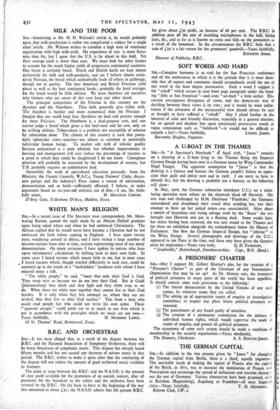MILK AND THE POOR
SIR,—Interesting as Mr. H. D. Walston's article is, he would probably agree that milk-production is rather too complicated a subject for a single short article. Mr. Walston wishes to correlate a high state of veterinary organisation with high milk-yield. My experience of vets is more fortu- nate than his, but I agree that the U.S. is far ahead in this field. Yet their average yield is lower than ours. We must look for other factors to account for the much higher yields of progressive continental countries. One factor is certainly breed. Dutch and Danish herds are kept almost exclusively for milk and milk-products, and are I believe almost exclu- sively Friesian, the breed which undoubtedly leads all others in gallonage, though not in quality. The best American and British Friesians yield about as well as the best continental herds ; probably the herd averages for the breed would be little inferior. We must therefore ask ourselves why farmers who are aware of this ever keep any other breed.
The principal competitors of the Friesian in this country are the Ayrshire and the Shorthorn. They both generally give richer milk. The Ayrshire is hardier and more economical than the Friesian: I imagine that one could keep four Ayrshires on feed and pasture enough for three Friesians. The Shorthorn is a dual-purpose cow, and one cannot judge a breed which gives a fair beef-steer and fat cow, only on its milking abilities. Tuberculosis is a problem not susceptible of solution by exhortation alone. The climate of this country is such that poten- tially tubercular cows—reactors—are almost as common as potentially tubercular human beings. To market safe milk of inferior quality because pasteurised is a poor solution, but whether improvements in housing and management will ever reduce the percentage of reactors to a point at which they could be slaughtered I do not know. Contagious abortion will probably be mastered by the development of serums, but T.B. probably requires an authoritative lead.
Meanwhile the work of agricultural education proceeds: from the Ministry, the County Councils, W.A.C.s, Young Farmers' Clubs, discus- sion groups and the industry's Press comes a stream of information, demonstration and so forth—sufficiently effectual, I believe, to make arguments based on six-year-old statistics out of date.—I am, Sir, faith-






















 Previous page
Previous page